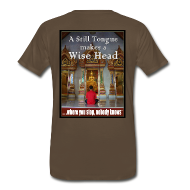I went to a therapist after a job loss, one year after I bought my first house alone which brought up all kinds of things. Probably the second time of seeing and talking to the therapist, and reliving the strain of my alcoholic father as a child, who I also lost 2 years before the job loss, some small wisdom starting creeping in. This therapist is going to have to make me feel comfortable with change, either by crying it out or talking it out, but it is ultimately up to me to change. At first because my wisdom was very weak, what came up first was I will save money and just quit going to see her. I did not know how and I wasn’t cured or had less anger/sadness. Instead, I just plowed through life as best as I could until my near death and bi-lateral strokes which happened just three years after my job loss. After I started my own business to gain my control over my life I later found out that anything you “do” with any external circumstances, does not bring wisdom internally. I had a ton of traumas to deal with, and certainly no more than anyone else, but it was time.

One really has to dig deep to
unveil what is your motivation with or during any change.
The payoff can be amazing with
wisdom sometimes trickling in slowly even while the path to emotional and spiritual
well-being can be quite long. My own path, small meditations and later after my first 10-day Vipassana, II could see I was not wise by any means... I did see the exposure of quite a bit of
what I was holding on to and carrying around inside of myself. This led to my yearly holiday bronchitis attack
that I usually suffered through … end just like that. The beginning of a meditation practice I had
started after realizing that doing the same old things and expecting a different
outcome was the definition of ignorance. I needed to change something and now,
I had someone that it was important to keep.
I saw after a year and half of practice I could see anger arising a few
times, and get an extra second in time where I could decide or not whether to
explode and figure out what would be a better outcome. This led me to wanting
to pursue not healing my medical nightmare but instead healing what can be the
root of what is holding me back from healing the body the best that I can. It
can take many different methods to facilitate your spiritual and emotional healing
and I am in no way saying mine is the best way, but it is an important key to
healing this older body. Find the one that best suits your disposition. What do you really want besides healing? Happiness and mature growth, affecting all those around you making you a beacon?



















